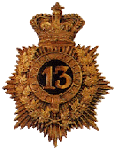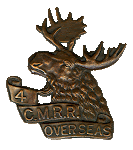Private Gill Joins the CEF
Thomas Gill attested to the Canadian Expeditionary Force (CEF) on July 31, 1915 in Barriefield Ontario, a historic village across the Cataraqui River from downtown Kingston. At the time he signed up he listed his occupation as a "Teamster". He was born in Lancashire, England on June 18, 1893, thus he was 22 years 1 month old when he joined the CEF. Thomas Gill weighed only 140 pounds at enlistment, a significant fact as you follow the rest of his service.
Private Gill noted that he had previous military experience as a member of the 13th Royal Regiment of the Canadian Militia in Hamilton, Ontario. In 1920 this regiment became the "Royal Hamilton Regiment", which by 1927 lead to the creation of the "Royal Hamilton Light Infantry". Many of the men of the 13th went to the CEF to serve in the 4th, 76th, 86th, 120th, and 205th Infantry Battalions of the CEF. Private Gill did not follow the majority, rather he joined the 8th Regiment of the Canadian Mounted Rifles (CMR). His Attestation Papers #113247 show his original regimental number in "C" Squadron as 8718, in the 8th CMR series of 8001-9000 which was later changed to 113051-114000.
The 8th CMR was organized on March 15, 1915 in support of the recruitment drive for the Great War, although it never served as an active unit in the field action in France and Flanders. The battalion was broken up to provide reinforcements for the Canadian Corps in the field. Although the Canadian Mounted Rifles served as "mounted troops" in the Boer War, none of the CMR units served in that capacity in the Great War. Prior to arriving in France, all the CMR units were dismounted to serve as front line infantry units.
Service Record of Thomas Gill
The service records for Private Thomas Gill were retrieved from Library and Archives Canada in September 2008, at the request of Grandson Jim Gill (Milton Canadian Legion, Branch 136). It is from these documents and a number of reference texts that this summary document has been prepared.
Private Gill trained with the 8th Regiment, Canadian Mounted Rifles in Canada from July 1915 to October 1915.
Upon arrival in Bramshot, England Private Gill was transferred for overseas service with the 8th Infantry Brigade, on January 28, 1916. The CMR units were initially proposed for service in the Middle East, however there was a more pressing need for dismounted troops to build the new 3rd Canadian Division that was being formed. The 8th Infantry Brigade of the 3rd Canadian Division became the home of all the CMR units that served in France and Flanders in the Great War. The 8th Infantry Brigade of the 3rd Canadian Division was composed of four (4) Canadian Mounted Rifle (C.M.R) units that were "dismounted" and used as regular Infantry Battalions. As such the 8th Infantry Brigade consisted of the Brigade Headquarters, the 8th Trench Mortar Battery and the 1st C.M.R., 2nd C.M.R., 4th C.M.R. and 5th C.M.R. The 3rd CMR was broken up to reinforce the 1st and 2nd CMR, the 6th CMR was broken up to reinforce the 4th and 5th CMR. The 7th, 9th, 10th, 11th, 12th and 13th CMR units were broken up to provide reinforcements to other units in the field.
On January 29, 1916 Private Gill landed in France and was taken-on-strength to the 4th Canadian Mounted Rifles at the Canadian Base Depot. He left for the 4th CMR in the field on February 7, 1916, joining the unit on February 10, 1916. Private Gill's records show that he was absent from the front line 4th CMR unit from April 14, 1916 until April 29, 1916 for service at the 8th Brigade Headquarters. On June 2, 1916 he was reported as "Missing After Action". Private Gill's medical records state that on June 2, 1916 he was "blown up", as were many of the 4th CMR men who suffered through that incredible artillery barrage.
We know from the historical records (see Nicholson Chapter 5) that the 8th Brigade had the unfortunate honour of taking the brunt of the German artillery attack at Mount Sorrel during the infamous battle of June 2nd 1916. The placement of the 4th CMR on that date is shown in Nicholson Map 4a. The 8th Infantry Brigade was defending the threatened area of Observatory Ridge. The 4th CMR was in front of Armagh Wood, the area heaviest hit by the German artillery fire that day. The trenches and garrisons of the 4th C.M.R. were annihilated, with 89 percent casualties. Of 702 men and officers on the line only 76 came through unscathed. Brig.-Gen. Williams was captured and the commander of the 3rd Division (General Mercer) was killed. Private Gill was very lucky that he survived the action of June 2, 1916 - as many of his cohorts did not!
The details of the day-to day action of the 4th Canadian Mounted Rifles is detailed in the on-line 4th CMR War Diary. The report of the action on June 2, 1916 is quite detailed and it reports on the devastation of June 2, 1916.
"We were bombarded in the front line, supports and reserves, by thousands of shells of every description. The bombardment was most intense. The front line was also bombarded by trench mortars. The O.C. of the platoon in S.P. 12 held his position until about 11:30 am when he sent out his remaining men who were mostly wounded, and when the last man had left came out himself.
A mine exploded on the battalion front line about 1 pm and an order came down the line to withdraw. At this time the whole front line was flattened out and there were no trenches of any description, and very few of the battalion that were able to carry on".
(transcription by R. Laughton)
With the devastation of the 4th Canadian Mounted Rifles it was probably some time before all the men could be accounted for after the lines were overtaken by the 26th and 27th Wurttemberger Division. As early as July 5, 1917 Private Gill was unofficially reported as a Prisoner of War (POW) in Germany, however it was not until July 19, 1916 that official word was received that Private Gill was a POW at the Dulmen Prison Camp (Germany: Nordrhein Westfalen, Munster, Dulmen - click here for photographs of the camp).
Private Gill as a Prisoner of War & Medical Casualty
 Private Gill was taken prisoner by the Germans at the Battle of Mount Sorrel on June 2, 1916. He served out the rest of the war as a prisoner at Dulmen Camp (Westphalia Province), working in the coal mines and quarries. There is a notation in the service record of Private Gill that he was unofficially transferred to the POW camp at Friedrichsfeld (Rhein Province). You will recall that Thomas Gill weighed only 140 pounds when he enlisted in 1915. As a POW it was reported he lost 50 pounds, so weighed a mere 90 pounds when he was repatriated after the Armistice. His medical records reported that he suffered from frequent colds and chest pains while a POW in German, was generally weak, but tested negative for Tuberculosis.
Private Gill was taken prisoner by the Germans at the Battle of Mount Sorrel on June 2, 1916. He served out the rest of the war as a prisoner at Dulmen Camp (Westphalia Province), working in the coal mines and quarries. There is a notation in the service record of Private Gill that he was unofficially transferred to the POW camp at Friedrichsfeld (Rhein Province). You will recall that Thomas Gill weighed only 140 pounds when he enlisted in 1915. As a POW it was reported he lost 50 pounds, so weighed a mere 90 pounds when he was repatriated after the Armistice. His medical records reported that he suffered from frequent colds and chest pains while a POW in German, was generally weak, but tested negative for Tuberculosis.Private Gill was repatriated back to England after the Armistice, arriving back in England on or about November 23, 1918 where he was posted at the No. 36 Camp at Ripon. There he was placed in the Central Ontario Regimental Depot and at a Convalescent Rest Camp at Witley, England until January 25, 1919.Private Gill returned to Canada on board the S. S. Regina, departing Liverpool England on March 22, 1919. His medical records show that he was treated for Laryngitis on board the ship on March 24th to 26th, 1919.
Upon arrival back in Canada, on or about April 1, 1919, Private Gill was posted to Casualty Company "J" in Hamilton , Ontario. On April 8, 1919 he was admitted to the College Military Hospital in Toronto, Ontario . Thomas Gill was suffering from his time in the trenches of France and the prisoner of war camps in Germany. He suffered from sleeplessness, nightmares, and general weakness (he had lost 50 pounds), generally classified as Neurosthenia. He was easily excited or startled, but he improved steadily and was discharged on May 20, 1919. It was reported that upon release he still had slight neurosis and that he might have a "slight incapacity for civil life". He was to receive further hydrotherapy (Scotch Douche), occupational therapy and tonic, and was expected to be fully fit in 3 months. He was posted to the Casualty Company Park School and given a $75 gratuity "War Service Gratuity" on May 271, 1919.
Private Gill was officially discharged from the Canadian Expeditionary Force on May 31, 1919. His medical records indicate that he was discharged as "medically unfit for general service", whereupon he would reside at 244 Catherine St. N., in Hamilton Ontario.
The final record in Private Gills file is the May 25, 1978 "Service Records Review" to establish his eligibility for "Prisoner of War" Compensation.
Notice:
The CEF WW1 Soldier Blog sites are best viewed on the Internet at the location shown on the bottom of each printed page. A printed copy may have been given to the family member for whom the summary report was prepared, in which case there may be additional attachments. If you are viewing the on-line version, please note that coloured underlined text is a hyperlink to a detailed document. All images in the main blog and the left side panel are also hyperlinked to other reports or images. For additional information, questions or comments e-mail Richard Laughton at or visit the Matrix Project.





